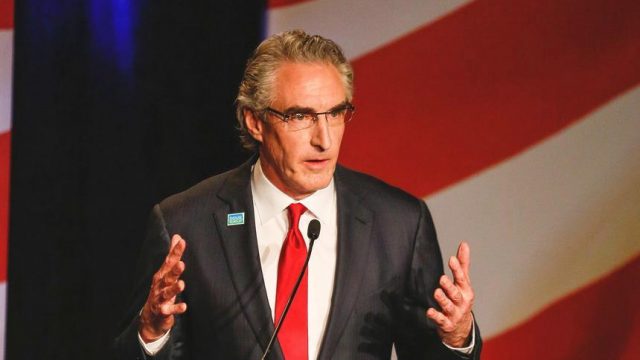Burgum Cuts Dalrymple’s Budget by Another $159 Million

Last month, shortly before leaving office, former Governor Jack Dalrymple delivered an executive budget to the Legislature. Which is a little unusual, that the outgoing governor would get to write a budget for the first two years of the incoming governor’s term in office.
But it is what it is.
Anyway, since his State of the State address to lawmakers earlier this month Governor Doug Burgum has been promising tweaks to Dalrymple’s budget. In a press release today we finally get a peek at what those tweaks are.
The amount to a $159 million reduction from Dalrymple’s proposed 2017-2019 budget. Which, really, isn’t that much. Especially considering Burgum’s aggressive campaign last year as a fiscal conservative. Still, in his defense, he didn’t exactly have a lot of time in office before the legislative session began and he pretty much had to use Dalrymple’s budget as a starting point.
Burgum all but said during his State of the State address that the budget for the next biennium will be a truer reflection of his philosophies and priorities.
Anyway, back tot he current biennium.
[mks_pullquote align=”right” width=”300″ size=”24″ bg_color=”#ffffff” txt_color=”#000000″]“Gov. Dalrymple’s budget was a good starting point. Unfortunately, revenues continue to fall short of projections, already lagging more than $15 million behind November’s revised forecast,” Burgum said in the release.[/mks_pullquote]
“Gov. Dalrymple’s budget was a good starting point. Unfortunately, revenues continue to fall short of projections, already lagging more than $15 million behind November’s revised forecast,” Burgum said in the release. “My budget proposal reflects this reality while prioritizing K-12 education and support for our state’s most vulnerable people.”
Burgum’s cuts include another 5 percent ($31 million) reduction in higher education funding, something he partially offsets by recommending an increase in funding for Challenge Grants from $3 million to $10 million.
The Challenge Grants program is state matching dollars for donations to the university foundations. So the problem I see is that Burgum is looking to replace legislative appropriations directly to our institutions of higher education with matched donations to the university foundations which have consistently resisted accountability under state transparency laws and stated, on the record, that they consider themselves private and separate from the universities themselves.
That seems…problematic.
Burgum also recommends a 1 percent decreases in state/campus employee salaries, K-12 schools, and the inflationary adjustment for Medicare providers. He also wants state employees to pay another $11 million toward their health insurance in the next biennium.
“These measures, while difficult in the short term, will position our state for long-term success with a leaner budget that is more adaptable to volatile swings in commodity prices,” Burgum said in the release.
And the property tax problem I’ve been writing about? The state buy downs have created a bubble in local property taxes. If the state stops the buy downs the locals will more than likely respond by raising property taxes. Burgum addresses this by ending the state’s 12 percent property tax buy down, but also moving spending on local social services to the state budget.
Burgum is also doing some interesting things on education funding:
With the flexibility provided by voters through the passage of Measure 2, Burgum also recommends using $200 million from the Foundation Aid Stabilization Fund to maintain state aid to K-12 schools at current levels – an increase of $60 million over the previous executive budget.
At the same time, his budget removes a proposed $200 million transfer from the Foundation Aid Stabilization Fund for school construction loans. Other options are available for school construction financing, including Bank of North Dakota funds, an interest buydown program and bonding.
This all seems reasonable enough to me. One problem area I see is that while Burgum touts readiness for volatility in North Dakota’s commodity-driven economy (read: the rise and fall of oil and crop prices), he seems on board with Dalrymple’s plan to invite more of that volatility into the state’s general fund.
Currently direct oil tax revenues are capped by law at $300 million in the general fund. The revenues over and above that amount flow to the various special fund “buckets” outside the general fund. In his proposed budget Dalrymple pushed that amount up to $1 billion, something lawmakers were a little skeptical of.
“Republican Ray Holmberg, chairman of the Senate Appropriations Committee, pointed to the experiences of other oil-rich states in arguing there’s some reluctance over relying too heavily on one revenue source for general government operations,” my colleague John Hageman reported earlier this month, though Holmberg did say the cap would likely have to be raised.
Burgum puts the cap at $900 million, which seems to be a point of contention among the lawmakers I’ve spoken to this evening.
If Burgum wants to avoid commodity volatility, why would you want so much of a directly commodity-driven revenue source in the general fund? It doesn’t sound like lawmakers want to go as high as $900 million. I’m told they might settle more in the $400 million – $500 million range.
Also of note is that Burgum would continue funding for the state’s expansion of the Medicaid program prompted by Obamacare.
Burgum’s full release is below.
[scribd id=336734835 key=key-2n7tCFt7uyOFEFl7KImk mode=scroll]




